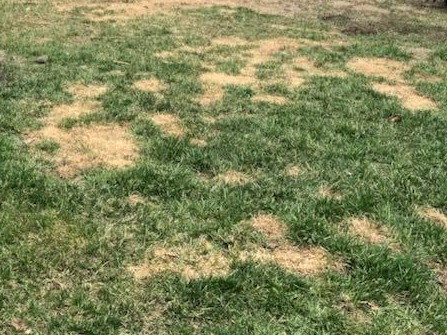Winter kill refers to any severe damage or death sustained by turf grass lawns during the winter months. Its primary signs are patches of lawn that remain brown or bare after the lawn normally returns to healthy green growth in the spring. For the most part, turf grasses that are well cared for will be resilient and strong, but winter weather can be unforgiving to even the best lawns. The dead patches that have suffered winter kill can take months to fill in again on their own and may require that you Re-Sod the lawn. Winter kill can occur under a variety of conditions.
Common Causes of Winter Kill:
Cold Desiccation
Grasses can survive just about any temperature if they are blanketed with snow because snow acts as an insulator. However, uncovered grasses in very cold conditions will continue to transpire (lose moisture and oxygen) well after the ground is frozen solid. Frozen roots cannot replace the moisture sucked away by cold, dry winds, and the plants may suffer cell death and perhaps even death of the plant crowns.
Treatment
Wait patiently to see if the grasses return to health. If the damage is minor, individual grass plants may recover, or surrounding grass plants may fill in. With widespread damage, you likely will need to Re-Sod dead areas.
Snow Mold
When heavy snow falls over ground that is not yet cold, the moist conditions may foster a variety of fungal diseases collectively known as snow mold. In the spring, when the snow melts, you will notice fuzzy or crusty patches, pink or gray in color, blanketing portions of the lawn. Snow mold usually dies as sun and breezes dry out the lawn, but if the turf has been infected for a long time, the grass may die. In this instance, over time, the grasses may gradually recover.
Treatment
If the lawn still has debris from the previous year, rake this up to improve air circulation to the grass. To prevent snow mold, make sure to de-thatch or aerate your lawn regularly, to improve air circulation.
Crown Freeze
The crowns of turf grass can be killed if warm, moist weather is followed by a sudden freeze. This is most common in late winter and early spring, especially when unexpected frost occurs in warm climates planted with warm-season grasses. When the crowns that have absorbed lots of water suddenly freeze, the expansion can kill the plant crowns.
Treatment
Widespread damage requires Re-Sodding. There is not much you can do to prevent the crowns from freezing.
Voles
A very identifiable type of winter kill is caused by voles—small rodents that leave narrow meandering bands of dead grass on the lawn. The mouse-like pests range in size from 3 to 9 inches, and they spend their winters tunneling beneath the snow or lawn debris, eating plant roots. The dead trails indicate the spots where the voles have completely eaten away the grassroots.
Treatment
Vole trails will usually fill in again as surrounding grasses send out new roots and shoots. With widespread damage, you may need to re-sod. To prevent voles, make sure to remove dead grass and fallen leaves in the fall since this material offers the rodents shelter for their winter adventures. Voles can be trapped and baited in the same fashion as mice, though this is difficult to do with snow cover.



Comments